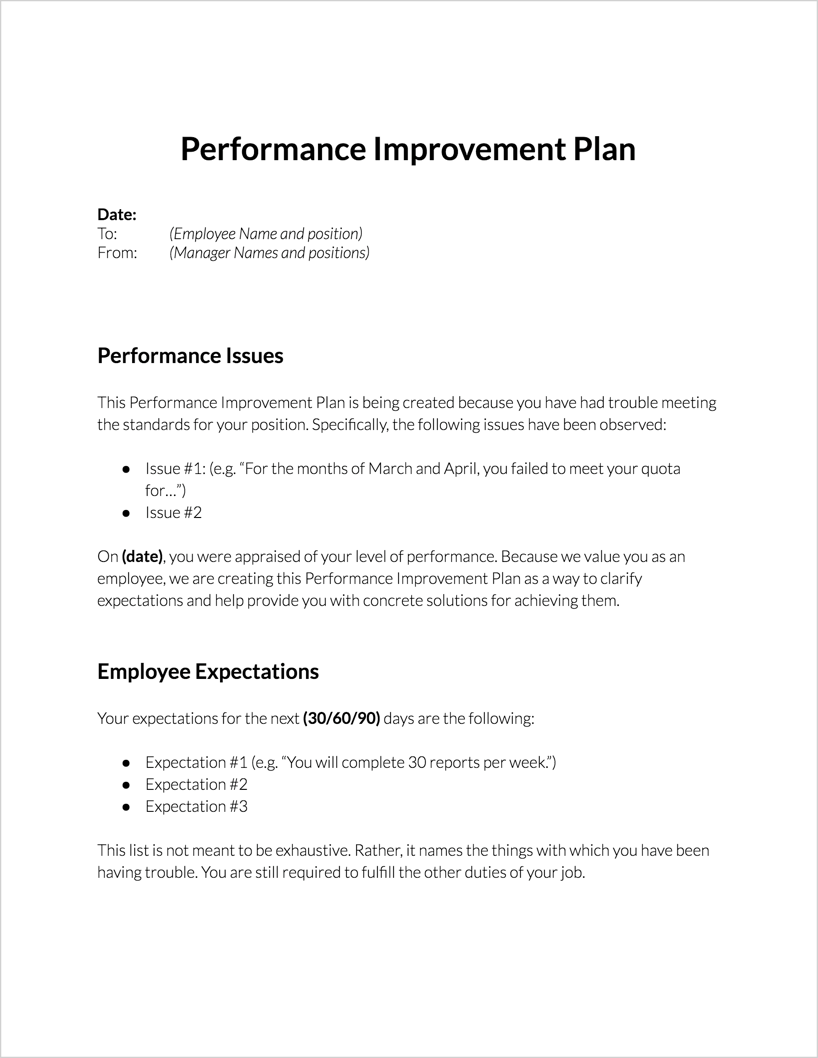
Performance Improvement Plan for Download
Employees can go through difficult times that may affect their work. Help them get back on track by setting up expectations and goals to work toward. Learn about the improvement plan process and best practices to make employee improvement a manageable and positive experience.
Download our free performance improvement plan template to get started!
What is a Performance Improvement Plan?
A Performance Improvement Plan (PIP) is a formal framework given to an employee who is underperforming at work. It describes specific steps the employee needs to take to improve, and sets up measurable goals for the employee to meet.
A PIP can be a standard component of regular feedback reviews, or it can be a special remedy for a particularly difficult situation. The PIP is usually produced as part of a conversation between an employee and her or his manager, and can be an effective way to keep employee and manager accountable for improving an employee’s performance.
Why use a Performance Improvement Plan?
Although it’s often derided as a strategy for management to justify a firing, in fact a Performance Improvement Plan can be a valuable tool in the HR toolbox.
Why? Because it’s a clear, objective way to put managers and employees on the same page.
In an ideal world, of course, managers and employees are always communicating, keeping one another abreast of what’s going well, and what isn’t. In the real world of deadlines and deliverables, however, this doesn’t always happen.
In fact, when an employee isn’t performing as well as he could be, managers — though they might jump to conclusions — don’t always know the reasons. A conversation around a PIP can help clarify. Has the employee received all necessary training? Are the job expectations clear to all parties?
By drawing up a PIP, managers can make sure that employees have all the tools available to be successful at their jobs, and that they know exactly what is expected of them. Employees can also be sure that they are being provided with those tools.
In short, a good PIP can make communication less turbulent. It can help managers become better mentors, and can help employees better do their jobs.
Components of a Performance Improvement Plan
A good Performance Improvement Plan generally has six components:
-
Performance Issues
This is where the manager describes ways the employee has not performed the job as well as he could have. Importantly, this is not a catch-all for complaints about an employee, or a laundry list of issues the manager has. Rather, it should objectively cite the issues with the employee’s work: goals that were not met, specific instances, relevant dates, and clear descriptions of the mismatch between expectations and performance.
The less personal this section can be, the better: managers should strive to be as objective as possible.
-
Employee Expectations
Here the PIP should specify, in as literal terms as possible, the work expectations for the employee over the next 60 or 90 days. Be specific:
- “Log 200 calls for the month of October.”
- “Reports must be filled out completely.”
- “Employee must be at her desk by 9am every day.”
- “Employee must complete no less than thirty deliverables per week.”
-
Employee Actions
This is where the PIP describes the specific actions the employee can take to achieve the expectations set out above. This section should always be completed in consultation with the employee, and partially in response to the manager asking “what steps can you take to reach these expectations?”
The point is for the manager to help provide the employees with the resources necessary to do their job well. Again, be specific:
- “Employee will attend a weekly training session, where she will review the company’s procedures for dealing with clients.”
- “At 9:00am, employee will email his manager a list of 5 tasks he will complete that day, and will send another email at 4:30pm reporting on the status of those tasks.”
- “Employee will have all reports read by a co-worker before submitting them to his manager.”
- “Employee will meet with manager once a week for ongoing evaluations of expectations.”
-
Manager Actions
Here the manager describes what he will do to help the employee. Daily check-ins? Short, weekly meetings? Acknowledgement that the employee is allowed to work from 10:00am to 6:00pm, and will not be punished for not responding to an 8:30am email?
By adding this section to the PIP, you assure your employee that the company is committed to the employee’s improvement.
-
Consequences
Set out the specific consequences for both meeting and not meeting those expectations. Often the consequence for failing to meet expectations is termination.
-
Signature
Both parties — manager and employee — should sign the PIP, acknowledging that they are committed to fulfilling the expectations it lays out.
Best Practices for Performance Improvement Plans
Best practices for a PIP certainly involve making sure all expectations are clearly defined, that HR works with the employee setting these goals, and continue checking in even after improvements are met.
-
Make the PIP a collaborative document
This is crucial. A PIP shouldn’t be an opportunity for a manager to simply list the things he doesn’t like about an employee. Rather, it should provide a roadmap for the employee to do a better job, given that it’s in everybody’s interest to have the employee improve.
The best way to do this is to work with the employee to develop strategies to help. Don’t just drop the PIP on an employee; let the employee contribute their thoughts and ideas.
Be firm about the fact that an employee is underperforming. But be open about solutions.
-
Be specific
In all parts of the PIP. Be very literal. “Doesn’t show up to work on time” isn’t specific. “From April 10-15, showed up at 9:30am every day” is. Similar with expectations and actions. The more specific you can be about problems and expectations, the less confusion there will be.
-
Follow up
There’s a reason why the last “P” in “PIP” is “Plan.” A PIP is a plan for the future. To be effective, it needs to be followed up on. Schedule meetings with the employee to assess how well the PIP is working. Make sure the PIP is laying out a sustainable plan that the employee can stick with long after the time limit in the PIP is done.

Performance Improvement Plan Template
Here’s a free performance improvement plan that’s easy to use and share.*
To use the PIP template:
- Download the template
- Open up the document in MS Word or Google Docs
- Edit the sections that are relevant to your organization
- Save the document under a new name
- Review the offboarding checklist with your HR or legal specialist
- Print the performance improvement plan to use!
*This performance improvement plan does not constitute legal advice. Please work with a legal or HR expert, as employment laws may vary country to country and state to state.



